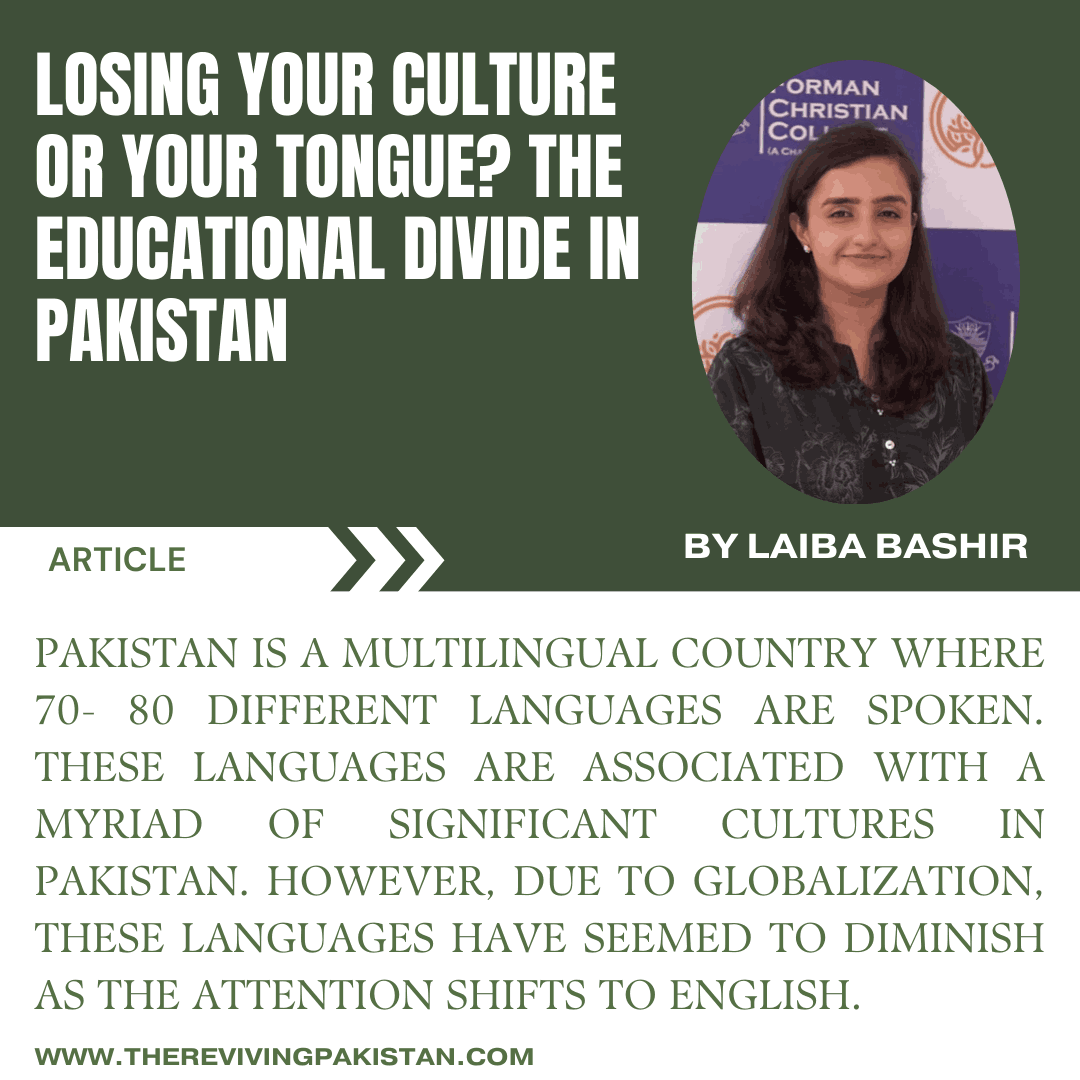About the Author(s)

Laiba Bashir
The author is a recent graduate from Forman Christian College University, Lahore, with double majors in Education and English Literature. Currently, she is pursuing her master’s in Education. Her passion for writing began in grade 5.
Pakistan is a multilingual country where 70- 80 different languages are spoken. These languages are associated with a myriad of significant cultures in Pakistan. However, due to globalization, these languages have seemed to diminish as the attention shifts to English. The educational institutes of Pakistan emphasize fluency in English and often disregard the background of the student and the mother language, this causes the student to be pressured to speak, read, write, and even communicate in English. Moreover, due to the country’s impoverishment, the resources needed to teach English in classroom settings particularly those in government schools need to be improved. The teachers are not qualified to teach English and beyond the lack of resources, the school often lacks proper infrastructure, potable water, and adequate washrooms for students.
The educational structure of Pakistan is perplexing in terms of the medium of instruction as the government schools tend to follow Urdu whereas private institutions use English. Claims supporting English as a medium of instruction are often substantiated and Urdu has consistently been considered a secondary language despite being the mother language and lingua franca of Pakistan. English has become a status symbol with fluent speakers seen as the part of elite class, further marginalizing Urdu speakers. The focus on fluent English speaking in private institutions has led to the abolishment of cultural languages and Urdu as a whole. This emphasis has weakened students’ foundational knowledge in subjects like Urdu, maths, and Islamiat since they are taught in a second language instead of their primary language. Thus the overwhelming importance given to English is leading to the abolishment of Urdu and other cultural languages. It is imperative to reverse the views since the situation is no longer pedagogic but rather pragmatic.
The use of English as the primary language can hinder a child’s cognitive development. In countries like Pakistan, parents, in their desperate attempt to make their children learn English often start using English at home. This approach has been criticized for psychological, analytical, and linguistic reasons. Using English a non-native language creates a communication barrier between the child and the parents. As English is not the native language, the child may struggle to freely express their opinions and emotions, leading to a loss of ancestral language. Research has shown that children who are not taught in their mother tongue can face delays in cognitive development, as they struggle with conceptual understanding in an unfamiliar language. Psychologically a child’s cognitive development is affected if the family background shows no familiarity with the native language, resulting in slow or conceptual development in students.
Additionally, the great divide of Pakistan’s educational structure into private and government schools creates greater competition in terms of following certain mediums of instruction in schools. Private institutions use English whereas government institutions Urdu. The main reason behind the prosperous growth of Private institutions is the use of Medium of instruction. According to research conducted to measure cognitive and academic achievement in government school students, English medium school students, and Cambridge school students. According to the research, the academic and cognitive abilities were found best in Cambridge students, then in English medium students. The government school students showed mediocre performance.
In terms of academic accomplishment and performance approach goals, female students outperform male students in another study by Tahir, Ghayas, and Adil (2012) on Punjabi secondary school students in Pakistan. The current study looked into the notable differences in academic achievement amongst teenagers enrolled in Cambridge, English-medium, and Urdu-medium schools. It is concluded that, in comparison to English-medium and Cambridge system schools, pupils attending Urdu-medium schools continued to do poorly academically. There are significant differences in the Cambridge, English, and Urdu school environments. When compared to Urdu, the number of students in each class is likewise lower in the Cambridge and English schools. As a result, teachers in Cambridge and English medium schools give each student more attention, whilst teachers in Urdu medium schools give each student less attention. These elements influence the parents’ choice of school. While parents with lesser socioeconomic levels and less education send their kids to schools in Urdu, educated parents, typically from the middle or upper class, prefer English or the Cambridge system.
Moreover, the teachers are not qualified enough in Pakistan whether they belong to private or government institutions. Dearden’s research, “English as a Medium of Instruction – A Growing Global Phenomenon,” sheds important light on the difficulties that developing nations like Pakistan, which do not speak English, encounter. It draws attention to the pervasive absence of the educational framework necessary to provide high-quality instruction in the English language, including a lack of teachers with the necessary language skills, ambiguous standards for English competency, and insufficient pedagogical guidelines. Using the British Council’s Aptis system, 2,008 teachers were tested in Pakistan, and the results showed that 62% of instructors in private schools and 56% of teachers in government schools performed in the lowest proficiency band, indicating a lack of basic English understanding. Furthermore, 44% of teachers in English-medium schools received a score in the lowest band, with 94% receiving a score at or below pre-intermediate. While younger instructors performed better in English than older ones, the total results paint a dismal picture, refuting the notion that teachers at private schools are more competent and highlighting a serious problem in education that has to be addressed right now.
Beyond adequate teachers and teaching the government schools suffer in proper infrastructure and resources. According to studies by Jones (2001) and Warwick and Reimers (2005), state schools are typically “dull” and “stringent,” with blue doors and windows with shattered glass panes and a filthy yellow paint job. According to these researchers, state schools are generally characterized by small, stuffy classrooms without student restrooms or washrooms; a lack of material resources; a lack of teacher commitment; a lack of collaboration among teachers; and an inadequate capacity for management. The decline in educational quality is another issue that has drawn a lot of criticism from state institutions. Teachers sometimes find it difficult to implement group tactics and activity-based learning because of space constraints, limited resources, and very large class sizes. As a result, students are often forced to memorize passages from boring, poorly written, and poorly printed books. The crammed classrooms also convey a very controlled and discipline-focused environment. Certain state schools, according to some analysts, are successfully and sufficiently preparing their kids for a bright future. However, the condition of the schools and the student’s future still seem morbid.
In conclusion, there are a lot of challenges and adverse consequences associated with Pakistan’s educational system giving English precedence over local tongues. Even though the goal might be to give students access to the world and improve their socioeconomic standing, the strategy has produced several problems, including impeding communication and cognitive development, maintaining socioeconomic disparities, and eroding cultural heritage. Government schools suffer from a lack of resources and facilities, which when combined with underqualified teachers makes matters worse and leaves many kids experiencing emotional and intellectual difficulties.
To maintain linguistic diversity and cultural identity while also providing students with the language skills they need for global engagement, the medium of instruction must be reevaluated and balanced. Pakistan can create an education system that honors its rich cultural legacy and effectively educates its children for the future by taking a more pragmatic and inclusive approach, giving equal weight to Urdu and English. To guarantee that all children, regardless of their socioeconomic situation, benefit from the educational system, quality education must be prioritized along with better training for teachers and attention paid to infrastructure problems. Pakistan may only attain a truly egalitarian and effective educational system that respects its linguistic and cultural diversity by taking such steps.


2 comments
Well said! Losing our mother tongue means losing a part of ourselves. We must act to preserve our linguistic heritage.
It is a timely reminder that language is not just a tool but a carrier of culture, identity, and tradition.
Comments are closed.